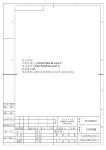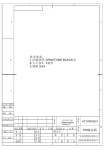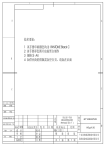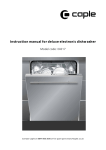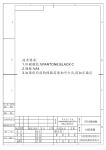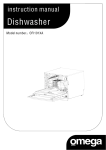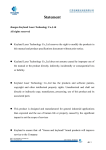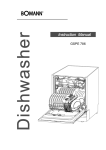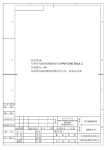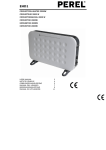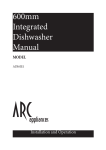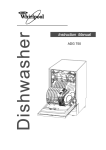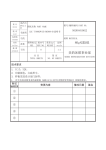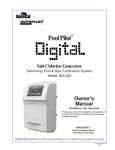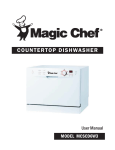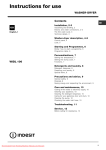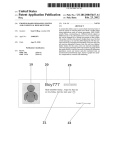Download Emilia Dishwasher EDW62SS User Manual
Transcript
1 2 A B A 技术要求: 1.印刷颜色为PANTONE BLACK C 2.该用户手册里的彩色图片也按黑白制作 3.规格为A5 4.如果供应商的排版需要加空白页,请加在最后 B C C 借 ( 通 ) 用件登记 描 图 描 校 旧底图总号 英文用户手册 EDW62SS(9240HY-AU) EMILIA澳大利亚 底图总号 签 日 字 期 标记 处数 设 计 审 核 工 艺 标准化 1 更改文件号 签 名 校对 审定 批准 日期 日期 比例 阶段标记 REV. 00 数 量 重 量 1 共 1 张 第 1 张 D 105G双铜 广东美的集团股份有限公司 美的洗涤电器制造有限公司 2 EDW62SS For detailed operating method read the corresponding content on the instruction manual. Switch on the appliance Fill the detergent dispenser Check the rinse aid level Load the baskets Select a programme Press the On/Off button to switch on the appliance, Open the door. With each wash cycle. Compartment For programmes with pre-wash only. (Follow the user instructions!) Electric indicator on control panel (if provided). Scrape off any large amount of leftover food. Soften remnants of burnt food in pans, then load the baskets. Refer to the dishwasher loading instructions. Press the Programme button until the selected programme lights up. ( See the section entitled“Operationg instruction”) Running the dishwasher Close the door, t urn on the water tap and press the Start/Pause button. The machine will start working after about 10 seconds. Changing the programme 1. A running cycle can only be modified if it has been running for a short time. Otherwise the detergent may have already been released and the water already drained. If this is the case, the detergent dispenser must be refilled. 2. Press the Start/Reset button for more than 3 seconds to cancel the running programme. 3. Select a new programme. 4. Restart the dishwasher. Add forgotten dishes in the dishwasher. 1.Open the door a little to stop the dishwasher. Open the doo r carefully. 2.After the spray arms stop working, you can open the door completely. Hot steam may esc ape 3.Add the forgotten dishes. 4.Close the door, the dishwasher will start running again after 10 seconds. when the door is opened! If the appliance is switched off during a wash cycle. If the appliance is switched off during a wash cycle, when switched on again, please re-select the washing cycle and operate the dishwasher according to the original Power-on state ). Switch off the appliance When the working cycle has finished, the buzzer of the dishwasher will sound 8 times, then stop. Turn off the appliance using the ON/OFF button. Turn off the water tap, unload the baskets Warning: wait a few minutes (about 15 minutes) before unloading the dishwasher to avoid handling the dishes and utensils while they are still hot and more susceptible to break. They will also dry better.Unload the appliance, starting from the lower basket. Dear Customer, This appliance is intended to be used in household and similar applications such as: -staff kitchen areas in shops, offices and other working environments; -farm houses; -by clients in hotels, motels and other residential type environments; -bed and breakfast type environments. Please carefully read this manual before using the dishwasher, it will help you to use and maintain the dishwasher properly. Keep it to refer to it at a later date. Pass it on to any subsequent owner of the appliance. This manual contains sections on safety Instructions, Operating Instructions, Installation Instructions and Troubleshooting Tips, etc. Control Panel...................................................2 Dishwasher Features............................ ......... ...2 A、Fill the Rinse Aid Dispenser................. . ........3 B、Function of Detergent ........................ ..........4 Attention before or after loading the Dishwasher Baskets...................................................... .. ..6 Loading the upper Basket............................ .. ...6 Loading the Lower Basket....................... ... .......7 Cutlery Basket........................................... ... ..7 Wash Cycle Table.................................. . .........9 Turning on the Appliance............................... . .9 Change the Programme...................... .............10 At the End of the Wash Cycle...................... ......10 To review the section on troubleshooting Tips will help you to solve some common problems by yourself . If you can not solve the problems by yourself , please ask for the help of professional technicians. Filtering System.............................................11 Caring for the Dishwasher...............................12 Water Connection............................................14 Positioning the Appliance.............................. ...........15 Start of Dishwasher .................... .....................15 Before calling for service.................................16 Error codes...................................................17 Technical information.....................................18 The manufacturer, following a policy of constant development and updating of the product, may make modifications without giving prior notice. WARNING! When using your dishwasher, follow the precautions listed below: This appliance must be grounded. In the event of a malfunction or breakdown, grounding will reduce the risk of anelectric shock by providing a path of least resistance of electric current. This appliance is equipped with a cord having an equipmentgrounding conductor and a grounding plug. The plug must be plugged into an appropriate outlet that is installed and grounded in accordance with all local codes and ordinances. Improper connection of the equipment-grounding conductor can result in the risk of an electric shock. Check with a qualified electrician or servi ce representative if you are in doubt whether the appliance is properly grounded. Do not modify the plug provided with the appliance; If i t does not fit the outlet. Have a proper outlet installed by a qualified electrician. Do not abuse, sit on, or stand on the door or dish rack of the dishwasher. Do not touch the heating element during or immediately after use. (This instruction is only applicable to machines with a visual heating element.) Do not operate your dishwasher unless all enclosure panels are properly in place. Open the door very carefully if the dishwasher is operating, there is a risk of water squirti ng out. Do not place any heavy objects on or stand on the door when it is open. The appliance could tip forward. When loading items to be w ashed: 1) Locate sharp items so that they are not likely to damage the door seal; 2) Warning: Knives and other utensils with sharp points must be loaded in the basket with their points down or placed in a horizontal position. When using your dishwasher, you should prevent plastic items from coming into contact with the heating element.(This instruction is only applicable to machines with a visual heating element.) Check that the detergent comparment is empty after completion of the wash cycle. Do not wash plastic items unless they are marked dishwasher safe or the equivalent. For plastic items not so marked, check the manufacturer's recommendations. Use only detergent and rinse additives designed for an automatic dishwasher. Never use soap, laundry detergent, or hand washing detergent in your dishwasher. Keep these products out of the reach of children. Keep children away from detergent and rinse aid, keep children away from the open door of the dishwasher, there could still be some detergent left inside. This appliance is not intended for use by persons (including children )with reduced physical, sensory or mental capabilities, or lack of experience and knowledge ,unless they have been given supervision or instruction concerning use of the appliance by a person responsible for their safety. Children should be supervised to ensure that they do not play with the appliance. Dishwasher detergents are strongly alkaline, they can be extremely dangerous if swallowed. Avoid contact with skin and eyes and keep children away from the dishwasher when the door is open. The door should not be left open, since this could increase the risk of tripping. If the supply cord is damaged, it must be repl aced by the manufacturer or its service agent or a similarly qualified person in order to avoid a hazard. Remove the door to the washing compartment when removing an old dishwasher from service or discarding it. Please dispose of packing materials properly. Use the dishwasher only for its intended function. During installation, the power supply must not be excessively or dangerously bent or flattened. Do not tamper with controls. The appliance is to be connected to the water mai ns using new hose sets and that old hose-sets should not be reused. The maximum number of place settings to be washed is 12. The maximum permissible inlet water pressure is 1Mpa. The minimum permissible inlet water pressure is 0.04Mpa. 1 To get the best performance from your dishwasher, read all operating instructions before using it for the first time. 2 Power indicator light and switch: To turn on/off and show the power supply. 3 Progra m in dicator lights and bu tton: To select one of the three and show the washing p rogram. Rinse aid warning lights: To show when the Rinse aid dispenser need to be refilled. 4 Start and Pause button: To start the selected washing program or reset the washing program when the mach ine is working. Back View Front view 6 1 2 3 7 4 8 5 9 1 2 3 Upper Basket Spray Arms Lower Basket 4 5 6 10 Main Filter Detergent Dispenser Cup Shelf 2 7 8 9 11 Cutlery Basket Coarse Filter Rinse Aid Dispenser 10 11 Drain pipe connector Inlet pipe connector Before using your dishwasher for the first time: A. Fill the rinse aid dispenser B. Fill in detergent Rinse Aid Dispenser The rinse aid is released during the final rinse to prevent water from forming droplets on your dishes, which can leave spots and streaks. It also improves drying by allowing water to roll off the dishes. Your dishwasher is designed to use liquid rinse aids. The rinse aid dispenser is located inside the door next to the detergent dispenser. To fill the dispenser, open the cap and pour the rinse aid into the dispenser until the level indicator turns completely black. The volume of the rinse aid container is about 110ml. Function of Rinse Aid Rinse aid is automatically added during the last rinse, ensuring thorough rinsing, and spot and streak free drying. Attention! Only use branded rinse aid for dishwasher. Never fill the rinse aid dispenser with any other substances (e.g. Dishwasher cleaning agent, liquid detergent). This would damage the appliance. When to Refill the Rinse Aid Dispenser If there is no rinse-aid warning light in the control panel, you can judge the amount of rinse-aid by the color of the optical level indicator "C" located next to the cap. When the rinse-aid container is full, the whole indicator will be dark .As the rinse-aid diminishes, the size of the dark dot decreases. You should never let the rinse aid get below 1 / 4 full. As the rinse aid diminishes, the size of the black dot on the rinse aid level indicator changes, as illustrated below. Full 3 / 4 full 1 / 2 full 1 / 4 full - Should refill to eliminate spotting Empty RINSE AID DISPENSER 1 2 3 To open the dispenser, turn the cap to the "open" (left) arrow and lift it out. Pour the rinse aid into the dispenser, being careful not to overfill. Replace the cap by inserting it aligned with "open" arrow and turning it to the closed (right) arrow. Be careful not to overfill the dispenser, because this could cause over sudsing. Wipe away any spills with a damp cloth. Don't forget to replace the cap before you close dishwasher door. Attention! Clean up any rinse aid split during filling with an absorbent cloth to avoid excess foaming during the next wash. 3 Adjusting Rinse Aid Dispenser The rinse aid dispenser has six scales. Always start with the dispenser set on "4". If spots and poor drying are a problem, increase the amount of rinse aid dispensed by removing the dispenser lid and rotating the dial to "5". If the dishes still are not drying properly or are show spots, adjust the dial to the next higher lever until your dishes are spot-free. The recommended setting is "4". (Factory value is "4".) NOTE: Increase the dose if there are drops of water or lime spots on the dishes after washing. Reduce it if there are sticky whitish stains on your dishes or a bluish film on glassware or knife blades. Detergents with its chemical ingredients are necessary to remove dirt, crush dirt and transport it out of the dishwasher. Most of the commercial quality detergents are suitable for this purpose. Concentrated Detergent Based on their chemical composition, detergents can be split in two basic types: conventional, alkaline detergents with caustic components low alkaline concentrated detergents with natural enzymes The use of“normal” washing programs in combination with concentrated det ergents reduces pollution and is good for your dishes; these wash programs are specifically matched to the dirt-dissolving properties of the enzymes of the concentrated detergent. For this reason “normal”wash programs in which concentrated detergents are used can achieve the same results that can otherwise only be achieved using “intensive” programs. Detergent Tablets Detergent tablets of different brands dissolve at different speeds. For this reason some detergent tablets cannot dissolve and develop their full cleaning power during short programs. Therefore please use long programs when using detergent tablets, to ensure the complete removal of detergent residuals. Detergent Dispenser The dispenser must be refilled before the start of each wash cycle following the instructions provided in the wash cycle table . Your dishwasher uses less detergent and rinse aid than Conventional dishwasher. Generally, only one tablespoon of detergent is needed for a normal wash load. More heavily soiled items need more detergent. Always add the detergent just before starting the dishwasher, otherwise it could get damp and will not dissolve properly. 4 Amount of Detergent to Use Detergent powder Detergent tablet If the lid is closed: press release button. The lid will spring open. Always add the detergent just before starting each wash cycle. Only use branded detergent aid for dishwasher. WARNING! Dishwasher detergent is corrosive! Take care to keep it out of reach of children. Proper Use of Detergent Use only detergent specifically made for the use in dishwashers. Keep your detergent fresh and dry. Don't put powdered detergent into the dispenser until you're ready to wash dishes. Fill in detergent Fill the detergent dispenser with detergent. The marki ng indicates the dosing levels , as illustrated on the right: A The place of main wash cycle detergent placed , “MIN”means approximately 20g of detergent. B The place of pre-wash cycle detergent placed , approximately 5g of detergent Please observe the manufacturers dosing and storage recommendations as stated on the detergent packaging. Close the lid and press until it locks in place. If the dishes are heavily soiled, place an additional detergent dose in the pre-wash detergent chamber. This detergent will take effect during the pre-wash phase. NOTE: You find information about the amount of detergent for the single programm es on the last page. Please aware, that according to the level soiling and the specific hardness of water differences are possible. Please observe the manufacturer's recommendations on the detergent packaging. Detergents There are 3 sorts of detergents 1.With phosphate and with chlorine 2.With phosphate and without chlorine 3.Without phosphate and without chlorine Normally new pulverised detergent is without phosphate. Thus the water softener function of phosphate is not given. In this case w e recommend to fill salt in the salt container even when the hardness of water is only 6 °dH. If detergents without phosphate are used in the case of hard water often white spots appear on dishes and glasses. In this case please add more detergent to reach better results. Detergents without chl orine do only bleach a little. Strong and coloured spots will not be removed completely. In this case please choose a program with a higher temperature. 5 For best performance of the dishwasher, follow these loading guidelines. Features and appearance of baskets and cutlery baskets may vary from your model. Attention before or after Loading the Dishwasher Baskets Scrape off any large amounts of leftover food. Soften remnants of burnt food in pans. It is not necessary to rinse the dishes under running water. Place objects in the dishwasher in following way: 1.Items such as cups, glasses, pots/pans, etc. are faced downwards. 2.Curved items, or ones with recesses, should be loaded aslant so that wate r can run off. 3.All utensils are stacked securely and can not tip over. 4.All utensils are placed in the way that the spray arms can rotate freely during washing. Very small items should not be washed in the dishwasher as they could easily fall out of the baskets. Removing the Dishes To prevent water dripping from the upper basket into the lower back, we recommend that you empty the lower basket first and then the upper basket. Loading the Upper Basket The upper basket is designed to hold more delicate and lighter dishware such as glasses, coffee and tea cup and saucers, as well as plates, small bowls and shallow pans (as long as they are not too dirty). Position the dishes and cookware so that they do not get moved by the spray of water. 1 2 3 4 Cups Glasses Saucers Dessert dishes THE UPPER RACK IS FOR MORE DELICATE AND LIGHTER DISHWARE SUCH AS GLASSES, COFFEE & TEA CUPS, SAUCERS, PLATES, BOWLS, AND SHALLOW PANS (PROVIDED THESE ARE NOT TOO DIRTY). POSITION THE DISHES AND COOKWARE SO THAT THEY DO NOT GET MOVED BY THE SPRAY OF WATER. ALWAYS PLACE GLASSES, CUPS & BOWLS UPSIDE DOWN. NOTE: POSITION 1 YOUR DISHWASHER COMES WITH AN ADJUSTABLE TOP RACK (BASKET) PICTURED AT RIGHT. ITS HEIGHT CAN BE ADJUSTED BY LIFTING THE HANDLE IN A DOWNWARD OR UPWARD DIRECTION. (PLS SEE THE FIGURES ON THE RIGHT: POSITION 1 & POSITONG 2.) NOTICE: ENSURE THE METAL ROD IS LOCATED IN ITS CORRECT POSITION. POSITION 2 *** NOTE ***: THE UPPER RACK HAS SIDE FLAPS (PICTURED AT LEFT ABOVE BASKET). THERE ARE 4 (2 ON EACH SIDE). THESE CAN BE ADJUSTED INTO 2 POSITIONS = POSITION 1 (HIGH) AND POSITION 2 (LOW). TO MOVE THE FLAPS BETWEEN THESE POSITIONS, LOCATE THE LARGE HINGES CLIP EACH FLAP TO THE UPPER RACK. THERE ARE TWO OF THESE AT EITHER END OF EACH FLAP. GENTLY PULL BOTH CLIPS OFF THE WIRE RACK AND MOVE THE FLAP TO THE DESIRED POSITION. BE CAREFUL IF YOU HAVE LONG FINGERNAILS! 6 POSITION 1 THE UPPER POSITION WILL ACCOMMODATE ITEMS SUCH AS GLASS TUMBLERS (PLACED BENEATH FLAP) AND WINE GLASSES. WINE GLASSES CAN BE PLACED UPSIDE DOWN SO THAT THE NECK RESTS IN THE GROOVES AT SIDE OF FLAP WITH THE BASE OF THE GLASS FACING UPWARD. POSITION 2 WHEN THE FLAPS ARE MOVED TO THE LOWER POSITION, THEY CAN BE USED TO HOLD ADDITIONAL TUMBLERS, CUPS AND MUGS. ALWAYS CHECK THAT YOU ARE ONLY PLACING ITEMS ON THE FLAPS THAT WILL CLEAR THE CEILING HEIGHT OF YOUR DISHWASHER WHEN YOU PUSH THE RACK BACK IN. BE PARTICULARLY CAREFUL WITH LONG-STEMMED GLASSWARE SUCH AS CHAMPAGNE GLASSES BREAKAGE HAZARD! Adjusting the Upper Basket The height of the upper basket can be adjusted in order to create more space for large utensils Both for the upper/lower basket. The height of the upper basket can be adjusted by placing the wheels on different height of the rails. Long items, serving cutlery, salad servers and knives should be placed on the shelf so that they do not obstruct the rotation of the spray arms. The shelf can be folded back or be removed when not required for use. Loading the Lower Basket We recommend that you place large items which are most difficult to clean into the low er basket: pots, pans, lids, serving dishes and bowls, as shown in the figure to the right. It is preferable to place serving dishes and lids on the side of the racks in order to avoi d blocking the rotation of the top spray arm. Pots, serving bowls, etc. must always be placed top down. Deep pots should be slanted to allow w ater to flow out. The bottom basket feature fold down tine rows so that larger or more pots and pans can be loaded. 4 Dessert dishes 5 6 7 Soup plates Dinner plates Silverware basket Folding spikes For better stacking of pots and pans, the spikes can be folded down as show in the picture right. Cutlery Basket Cutlery should be placed in the cutlery basket with the handles at the bottom. If the rack has side baskets, the spoons should be loaded separately into the appropriate slots, especially long utensils should be placed in the horizontal position at the front of the upper basket as shown in the picture. 7 4 1 2 3 4 5 Forks Soup spoons Dessert spoons Teaspoons Knife Do not let any item extend through bottom. Are not suitable Cutlery with wooden, horn china or mother-of-pearl handles Plastic items that are not heat resistant Older cutlery with glued parts that are not temperature resistant Bonded cutlery items or dishes Pewter or cooper items Crystal glass Steel items subject to rusting Wooden platters Items made from synthetic fibres Are of limited suitability Some types of glasses can become dull after a large number of washes Silver and aluminum parts have a tendency to discolour during washing Glazed patterns may fade if machine washed frequently NOTE: Do not put in items that are dirty of cigarette ash, candle wax, lacquer or pa int. If you buy new dishes please make sure that they are suitable for dishwashers. NOTE: Please do not overload your dishwasher. Do not use dish that is not suitable for dishwashers. This is important for good results and for reasonable energy consume. Loading cutlery and dishes Before loading the dishes, you should: Remove large left-over Soften remnants of burnt food in pans When loading the dishes and cutlery, please note: Dishes and cutlery must not impede the rotation of the spray arms Load hollow items such as cups, glasses, pans etc. with the opening downwards so that water cannot collect in the container or a deep base Di shes and items of cutlery must not lie inside one another, or cover each other To avoid damage to glasses, they must not touch Load large items which are most difficult to clean into the lower rack T he upper rack is designed to hold more delicate and lighter dishware such as glasses, coffee and tea cups Attention! Long bladed knives stored in an upright position are a potential hazard! Long and/or sharp items of cutlery such as carving knives must be positioned horizontally in the upper basket. Damage to glassware and other dishes Possible causes: Type of glass or manufacturing process. Chemical composition of detergent. Water temperature and duration of dishwasher programme. Suggested remedy: Use glassware or porcelain dishes that have been marked dishwasher-proof by the manufacturer Use a mild detergent that is described as kind of dishes If necessary, seek further information from detergent manufacturers. Select a programme with as low a temperature. To prevent damage, take glass and cutlery out of the dishwasher as soon as possible after the programme has ended. 8 ( Heavy Normal (*AS/NZS 2007.1) Rapid ) Means: need to fill rinse into the Rinse-Aid Dispenser. For heavily soiled loads, such as pots, plates, glasses and lightly soiled pans. standard daily cycle . Pre-wash(50℃) Wash (50 ℃) Rinse Rinse (65 ℃) Drying For normally soiled loads , such as plates, glasses, bowls and normally soiled pans. A shorter wash for lightly soiled loads that do not need dry ing. 5/25 g. 160 1.3 15 Wash (55 ℃) Rinse Rinse Rinse (50 ℃) Drying 5/25 g. 110 0.90 12 Wash (40 ℃) Rinse Rinse (45 ℃) 20 g. 30 0.5 12 * AS/NZS 2007.1 : This program is the test cycle. The in formation for comparability test in accord ance with AS/NZS 2007.1 , as follows: Capacity: 12 setting Position Upper ba sket: upper wheels on rails Rinse aid setting: 6 Open the door slightly 50mm to assist in drying of the dishes after every wash Starting a cycle wash Draw out the lower and up per b asket, load the dishes and push them back. It is commended to lo ad the lower bask et first, then the upper one (s ee the sectio n entitled “Loading the Dishwasher”). 2 Pour in the detergent (see the section e ntitled“Salt, Detergent and Rinse Aid”). 3 Insert the plug into the socket. The power supply is 220-240 VAC /50 HZ, the specification of th e socket is 10A 250VAC. Make sure that the water supply is turned on to full pressure. 4 Close the door, press the ON/OFF button, and the ON/OFF light will turn on. Press the program b utton to select a desired wash cycle. Then press the Start/Pause button to start the machine. 1 9 Premise: 1 A cycle that is underway can on ly be modified if it has on ly been running fo r a short time. Otherwise, the d etergent may have already b een released, and the a ppliance may have alread y drained the wash water. If this is the case, the detergen t dispenser must be refilled (see the section entitled " Loading the Detergent " ). 2 When you press the start/reset button more than 3 sec onds, you can cancel the running programme and selec t other pro grammes (see the section entitled " Starting a wash cycle. . . " ). If you open the door during a wash cycle , the machine will pause. When you close the door , the machine will continue working after 10 seconds. A forgotten dish can be added at any time before the detergent cup opens. 1 2 Open the door a little to stop the washing. 3 Load the forgotten dishes. After the spray arms stop working,you can open the door completely. 4 Close the door, the dishwasher will start running again after 10 seconds. When the wo rking cycle has finished, the buzzer of the dishwasher will sound for 8 seconds, then stop. Turn off the appliance using the ON/OFF button, shut off the water supp ly and open the door of the dishwasher. Wait for a few minutes before unlo ading th e dishwasher to avoid ha ndlin g the dishes and utensils while they are still hot and more susceptible to break age. The y will also dry better. Switch Off the Dishwasher 1.Switch off the dishwasher by pressing the ON/OFF button. 2.Turn off the water tap! Open the door carefully. Hot dishes are sensitive to knocks. The dishes should therefore be allowed to cool down around 15 minutes before removing from the appliance. Open the dishwasher's door, leave it ajar and wait a few minutes before removing the dishes. In this way they will be cooler and the drying will be improved. Unloading the dishwasher It is normal that the dishwasher is wet inside. Empty the lower basket first and then the upper one. This will avoid water dripping from the upper Basket onto the dishes in the lower one. It is dangerous to open the door when washing, because the hot water may scald you. 10 The filter prevents larger remnants of food or other objects from getting inside the pump. The residues may block the filter, in this case they must be removed. The filter system consists of a coarse filter, a flat (Main filter) And a microfilter (Fine filter). 1 2 1 3 Main filter Food and soil particles trapped in this filter are pulverized by a special jet on the lower spray arm and washed down the drain. 2 Coarse filter Larger items, such as pieces of bones or glass, that could clog the drain are trapped in the coarse filter. To remove an item caught in this filter, gently squeeze the taps on the top of this filter and lift it out. 3 Fine filter This filter holds soil and food residues in the sump area and prevents it from being redeposit on the dishes during a cycle. - Inspect the filters for blocking after every time the dishwasher has been used. - By unscrewing the coarse filter. you can remove the filter system. Remove any food remnants and clean the filters under running water. NOTE: When following this procedure from step1 to step 3, the filter system will be removed; when following it from Step 3 to Step 1, the filter system will be installed. 11 Filter assembly For best performance and results, the filter assembly must be cleaned. The filter efficiently removes food particles from the wash water, allowing it to be recycled during the cycle. For best performance and results, the filter must be cleaned regularly. For this reason, it is a good idea to remove the larger food particles trapped in the filter after each wash cycle by rinsing the semicircular fi lter and cup under running water. To remove the filter device, pull the cup handle in the upward direction. The entire filter assembly should be cleaned once a week. To clean the coarse filter and the fine filter, use a cleaning brush. Then, reassemble the filter parts as shown in the figures left and reinsert the entire assembly in the dishwasher, positioning in its seat and pressing downward. The dishwasher must never be used without the filters. Improper replacement of the filter may reduce the performance level of the appliance and damage dishes and utensils. The dishwasher must never be used without the filters. Improper replacement of the filter may reduce the performance level of the appliance and damage dishes and utensils. Cleaning the Spray Arms To remove the upper spray arm, screw off the nut clockwise then remove the arm. upper lower Caring for the Dishwasher The control panel can be cleaned by using a lightly dampened cloth. After cleaning, make sure to dry it thoroughly. For the exterior, use a good appliance polish wax. Never use sharp objects, scouring pads or harsh cleaners on any part of the dishwasher. Protect Against Freezing please take frost protection measures on the dishwasher in winter. Every time after washing cycles, please operate as follows: 1.Cut off the electrical power to the dishwasher. 2.Turn off the water supply and disconnect the water inlet pipe from the water valve. 3.Drain the water from the inlet pipe and water valve. (Use a pan to catch the water) 4.Reconnect the water inlet pipe to the water valve. 5.Remove the filter at the bottom of the tub and use a sponge to soak up water in the sump. 12 To clean the edge around the door, you should use only a soft warm, damp cloth. To avoid penetration of water into the door lock and electrical components, do not use a spray cleaner of any kind. Never use a spray cleaner to clean the door panel as it may damage the door lock and electrical components. Abrasive agents or some paper towels should not be used because of the risk of scratching or leaving spots on the stainless steel surface. When you go on holiday, it is recommend that you run a wash cycle with the dishwasher empty and then remove the plug from the socket, turn off the water supply and leave the door of the appliance slightly ajar. This will help the seals to last longer and prevent odours from forming within the appliance. After every wash, turn off the water supply to the appliance and l eave the door slightly ajar so that moisture and odours are not trapped inside. Before cleaning or performing maintenance, always remove the plug from the socket. Do not run risks. If the appliance must be moved, try to keep it in the vertical position. If absolutely necessary, it can be positioned on its back. To clean the exterior and rubber parts of the dishwasher, do not use solvents or abrasive cleaning products. Rather, use only a cloth and warm soapy water. To remove spots or stains from the surface of the interior, use a cloth dampened with water and a little vinegar, or a cleaning product made specifically for dishwashers. WARNING! One of the factors that cause odours to form in the dishwasher is food that remains trapped in the seals. Periodic cleaning w ith a damp sponge will prevent this from occurring. For personal safety: DO NOT USE AN EXTENSION CORD OR AN ADAPTER PLUG WITH THIS APPLIANCE. DO NOT, UNDER ANY CIRCUMSTANCES, CUT OR REMOVE THE EARTHING CONNECTION FROM THE POWER CORD. Please look at the rating label to know the rating voltage and connect the dishwasher to the appropriate power supply. Use the required fuse 10 amp, time delay fuse or circuit breaker recommended and provide separate circuit serving only this appliance. Ensure the vol tage and frequency of the power being corresponds to those on the rating plate. Only insert the plug into an electri cal socket which is earthed properly. If the electrical socket to which the appliance must be connecte d is not appropriate for the plug , replace the socket, rather than using a adaptors or the like as they could cause overheating and burns. This appliance must be earthed. In the event of a malfunction or breakdown, earthing will reduce the risk of electric shock by providing a path of least resistance for the electric current. This appliance is equipped with a cord having an equipment-earthing conductor and an earthing plug. The plug must be plugged into an appropriate outlet that is installed and earthed in accordance with all local standards and requirements. 13 WARNING! Improper connection of the equipment earthing conductor can result in the risk of an for personal safety: electric shock. DOaNOT USE AN EXTENSION CORD OR AN ADAPTER APPLIANCE. Check with qualified electrician or service representative if youPLUG are in WITH doubtTHIS whether the DO UNDER ANY CIRCUMSTANCES, CUT OR REMOVE THE EARTHING appliance is NOT, properly earthed. CONNECTION FROM THE POWER CORD. If the plug does not fit properly to the Do not modify the plug provided with the appliance. outlet, please have a qualified electrician to install a proper outlet. The appliance must be connected to the water mains using new hose-sets. The old hose-sets should not be reused. Water pressure must be between 0,04 MPa and 1 MPa. If the pressure is below the minimum consult our Service Department for advice. 1 2 3 Pull The safety supply hoses completely out from storage compartment located at rear of dishwasher. Tighter the screws of the safety supply hose to the faucet with thread 3/4inch. Turn water fully on before starting the dishwasher. The safety supply hose consists of the double walls. The hose's system guarantees its intervention by blocking the flow of water in case of the supply hose breaking and when the air space between the supply hose itself and the outer corrugated hose is full of water. A hose that attaches to a sink spray can burst if it is installed on the same water line as the dishwasher. If your sink has one, it is recommended thet the hose be disconnected and the hole plugged. 1 Turn off the water. the water pressure by depressing the pressure release button. This relieves water pressure and protects you, and the 2 Release room, from severe splashing. 3 Unscrew The safety supply hose from the faucet.. Connect the cold water supply hose to a threaded 3/4(inch) connector and make sure that it is fastened tightly in place. If the water pipes are new or have not been used for an extended period of time, let the water run to make sure that the water is clear and free of impurities. If this precaution is not taken, there is a risk that the water inlet can get blocked and damage the appliance. Insert the drain hose into a drain pipe with a minimum diameter of 4 cm, or let it run into the sink, making sure to avoid bending or crimping. Use the special plastic support that comes wi th the appliance. The free end of the hose must be at a height between 40 and 100cm and must not be immersed in water. SINK DISHWASHER T E L T U O R E W O P Inlet pipe connector Drain pipe connector FRONT VIEW Min 100mm 14 Position the appliance in the desired location. The back should rest against the wall behind it, and the sides, along the adjacent cabinets or walls. The dishwasher is equipped with water supply and drain hoses that can be positioned either to the right or the left sides to facilitate proper installation. Once the appliance is positioned for levelling, the height of the dishwasher may be altered via adjustment of the screwing level of the feet. In any case, the appliance should not be inclined more than 2 . Water Outlet Connect the water drain hose. The drain hose must be correctly fitted to avoid water leaks. Ensure that the water drain hose is not kinked or squashed. Extension Hose If you need a drain hose extension, make sure to use a si milar drain hose. It must be no longer than 4 m etres; otherwise the cleaning effect of the dish washer could be reduced. Syphon Connection The waste connection must be at a height of between 40 cm (minimum) and 100 cm (maximum) from the bottom of the dish. The w ater drain hose should be fixed by a hose clip. The free end of the hose must not be immersed in water. The following things should be checked before starting the dishwasher. 1 The dishwasher is level and fixed properly 2 The inlet valve is open 3 There is a leakage at the connections of the conducts 4 The wires are tightly connected 5 The power is switched on 6 The inlet and drain hoses are knotted 7 All packing materials and printings should be taken out from the dishwasher After installation, please make sure to keep this manual. The content of this manual is very helpful to the users. 15 Technical problems General problems Fuse blown, or the circuit breaker acted Replace fuse or reset circuit breaker. Remove any other appliances sharing the same circuit with the dishwasher Power supply is not turned on Make sure the dishwasher is turned on and the door is closed securely. Make sure the power cord is properly plugged into the wall socket. Error code:E1; W ater pressure is low Check that the water supply is connected properly and the water is turned on. Door of dishwasher not properly closed. Make sure to close the door properly and latch it. Kink in drain hose Check drain hose. Filter clogged Check coarse the filter (see section titled " Cleaning The Filter ") Kitchen sink clogged Check the kitchen sink to make sure it is draining well. If the problem is the kitchen sink not draining ,you may need a plumber rather than a serviceman for dishwashers. Improper detergent Use only the special dishwasher detergent to avoid suds. If this occurs, open the dishwasher and let suds evaporate. Add 1 gallon of cold water to the tub. Close and latch the dishwasher, then Start the "soak" wash cycle to drain out the water . Repeat if necessary. Spilled rinse-aid Alw ays wipe up rinse-aid spills immediately. Detergent w ith colourant w as used Make sure that the detergent is the one without colourant. Hard water minerals To clean the interior, use a damp sponge with dishwasher detergent and wear rubber gloves. Never use any other cleaner than dishwasher detergent for the risk of foaming or suds. The affected items are not corrosion resistant. Alw ays run the quick wash programme . A programme was not without any crockery in the dishwasher and run after dishwasher salt was added. without selecting the Turbo function (if present), after adding dishwasher salt. Traces of salt have gotten into the w ash cycle. Noise The lid of the softer is loose Check the lip .Ensure the fix is fine. A spray arm is knocking against an item in a basket Interrupt the programme, and rearrange the items which are obstructing the spray arm. Items of crockery are loose in the wash cabinet Interrupt the programme, and rearrange the items of crockery. This may be caused by on-site installation or the cross-section of the piping. This has no influence on the dishwasher function. if in doubt, contact a suitably qualified plumber. 16 Unsatis -factory washing result Unsatis -factory drying result The dishes were not loaded correctly. See notes in " Loading the Dishwasher Baskets ". The programme was not powerful enough. Select a more intensive programme. See" Wash Cycle Table ". Not enough detergent was dispensed. Use more detergent, or change your detergent. Items are blocking the path of spray arms. Rearrange the items so that the spray can rotate freely. The filter combination in the base of wash cabinet is not clean or is not correctly fitted. This may cause the spray arm jets to get blocked. Clean and/or fit the filter combination correctly. Clean the spray arm jets. See "Cleaning the Spray Arms". Combination of soft water and too much detergent. Use less detergent if you have soft water and select a shortest cycle to wash the glassware and to get them clean. Aluminum utensils have rubbed against dishes. Use a mild abrasive cleaner to eliminate those marks. Dishes block detergent cups. Re-loading the dishes properly. Improper loading Load the dishwasher as suggested in the directions. Too little rinse-aid Increase the amount of rinse-aid/refill the rinse-aid dispenser. Dishes are removed too soon Do not empty your dishwasher immediately after washing. Open the door slightly so that the steam can escape. Begin unloading the dishwasher only once t he dishes are barely warm to the touch. Empty the low basket first. This prevents water form dropping off dishes in the upper basket. W rong program has been selected In short program the washing temperature is lower. This also lowers cleaning performance. Choose a program with a long washing time. Use of cutlery w ith a low-quality coating Water drainage is more difficult with these items. Cutlery or dishes of this type are not suitable for washing in the dishwasher. When some malfunctions come on, the appliance will display error codes to warn you: The soak light flicker fleetly. The rapid light flicker fleetly. The normal light flicker fleetly. Longer inlet time. Tap is not opened, or water intake is restricted,or water pressure is too low. Longer draining time. The installation position of the drain pipe is too high. Over flow Some element of dishwasher leaks . If overflow occurs, turn off the main water supply before calling a service. If there is water in the base pan because of an overfill or small leak, the water should be removed before restarting the dishwasher. 17 Height : Width : Depth : Voltage connected Load : Water pressure: Power supply: Capacity: 850mm 600mm 580mm see rating label 0.04-1.0MPa see rating label 12 Place settings 18























